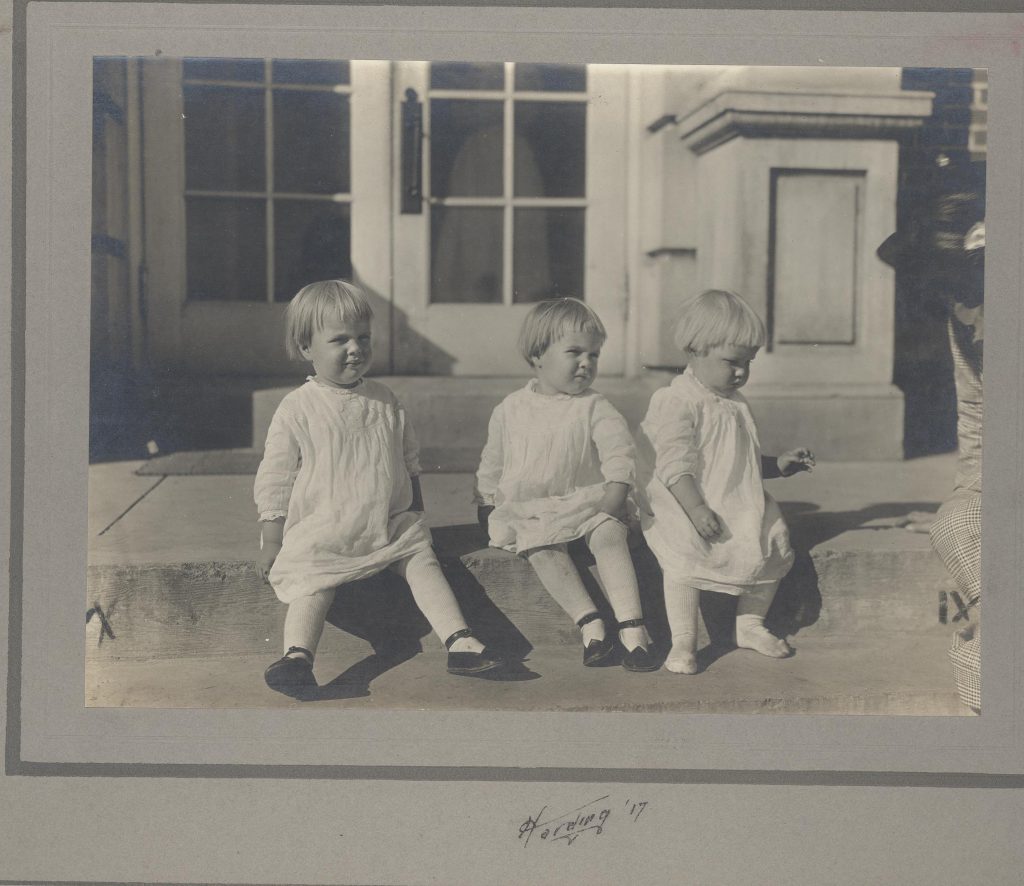The Triplets Story

Fables or fairytales often begin with the words “Once Upon a Time,” but this story is neither a fable or a fairytale. Under the circumstances, however, I think it’s only fitting to begin this story that way. So, here goes.
Once upon a time in the Dodson Chapel community near Rickman, there lived a carpenter by the name of Joshua Moore who was called Josh for short. Evidently, Joshua Moore was well known for his fine carpenter skills as evidenced by the home he helped to for nearby neighbors, Frank and Mary Swallows. Their home still stands today. Joshua Moore married Mary Elizabeth Duncan, the daughter of John and Sarah, or Sallie as she was known by, (Barnes) Duncan. Mary Elizabeth’s father, John Duncan, came from Scotland to America, and in April of 1896, he donated land for the establishment of the Duncan’s Chapel church.
Although Mary Elizabeth had three other children, it was while she and Joshua were living as neighbors to Frank and Mary Swallows that their lives changed completely. It surely must have been a great shock when on March 25,1915, Mary Elizabeth gave birth to not one baby, not two babies, but three. Triplets! The babies were given the names Mary Lera, Sarah Vera, and Era Jane. Later, most everyone who knew the girls referred to them as Lera, Vera, and Era. In October of 1957, Austin Wheeler Smith, who was Dean-Registrar Emeritus of Tennessee Polytechnic Institute, published a book titled “The Story of Tennessee Tech.” The following paragraph about the Moore triplets is taken from page 107 of that book: “The Home Economics staff during the early years of Tech took a special interest in the Moore triplets, Vera, Lera, and Era, born on March 25, 1915, at Rickman, Tennessee. Miss Lura C. Robinson who was head of that department became, in some respects, their godmother. Her domestic arts classes as a class project made clothing for them for a number of years.”

When the Moore triplets were around 10 years of age, the family moved away to the state of Michigan. It was there their father died not long after the move. He was buried in a pauper’s grave somewhere in Battle Creek, Michigan. Mary Elizabeth Moore lived to be 101 years of age, and is buried in Bellevue Michigan cemetery.
Time, as always, moves along, children grow up, people pass away, leaving behind possessions and other personal items that often become treasures to loving family members. Such is the case with a picture box belonging to Frank and Mary Swallows that ended up with their granddaughter, Paula Swallows Stover. Among the many photographs in that box were several pictures of the triplets who once lived as neighbors to Paula’s grandparents. “Wonder whatever happened to those little girls?” Paula often asked herself, and in an effort to see if anyone might know the answer to that question, Paula placed one of the pictures in the Cookeville Herald Citizen way back in 1998 hoping someone would get in touch with her with information. Time continues to go on, no answer comes. That is until some 17 years later.
Now comes Part Two of our Once Upon A Time story.
On May 18, 1948, a baby girl was born in Women’s Hospital of Detroit, Michigan who was given the name Judith Ann Moore. The mother of this baby girl was legally deaf, an affliction she suffered from childhood on. She was described as a very petite young woman, just 5′ 1″ tall, and quite pretty. She had her own apartment and worked in a laundry in a hospital where it is believed she got involved with a married man. After giving birth, the mother and baby went to stay with an older woman. For unknown reasons, when she was only 10 days old, the baby ended up in the nursery of Henry Ford Hospital, and was later, at six weeks of age, was placed in a foster home. In the meantime, the baby’s mother, who wanted desperately to keep the child, tried to find someone who would be willing to marry her and provide a home for herself and the new baby. But that never happened. Many years later it was determined through DNA testing the father of her child was Coy Philmore Absher, born in Wilkes County North Carolina in 1916. He served in the army during World War II in Ft. Custer near Battle Creek. When questioned by the doctor of the baby’s mother about the possibility of his being the father, he admitted that might very well be the case, but he thought there could be others as well. The father died of a heart attack in 1962, having never made contact with his daughter who was 14 years old when he died.
The baby remained in foster care until April of 1949 when she was adopted by Maurice and Donna Reighter. She was 11 months old at the time of the adoption, and was given the name Diane Reighter. Diane grew up in a loving home with the best of parents. Some of her favorite childhood memories include summers spent in a cottage her adoptive parents owned in northern Michigan that stood near a quiet fishing lake. Relatives often filled the other nearby cottages, and fun times would be spent gathered around a campfire while Diane’s grandfather played the banjo and everyone sang songs and old hymns. Diane graduated from Jackson High School in Jackson, Michigan, and afterward, attended Moody Bible Institute in Chicago for a year. While a student there, she traveled with a choral group from that school to Scotland and England.
In 1971, Diane married Jerry Wortz and moved to Coldwater, Michigan. Their family eventually grew to include a son, Jeremy, and a daughter, Candice. When Diane and Jerry’s first grandchild was born, the baby’s parents were only 17 years old, and a very difficult decision was made, and the baby was placed for adoption. During a session with the adoption agency, Diane just happened to mention she was adopted, but knew nothing about her situation. When she was asked if she would like to obtain just the basic information about her adoption, she said she would, thinking it might prove to be interesting. But she never expected to learn very much about her parents. However, when she got a call from a young female intern who was handing her request, she was told she had “an extensive file.” It was then that she learned not only was her mother one of the triplets born in the Rickman community in 1915, but there were living relatives. Sadly, Diane’s mother, Mary Lera Moore, who never married, died at the age of 70. She did get some good news though. Diane’s Aunt Vera was still living, and her Aunt Era, who passed away in the 1970s, had a daughter, Mary, and a son, David. Diane and her husband soon made arrangements to meet Mary and David. During the visit, the cemetery where her Diane’s grandmother, her mother and her aunt were buried was one of the places they went to. In June of that same year, Diane got to meet the only one of the triplets still living, her Aunt Vera, and at that visit, her aunt gave her a doll that had been her mother’s. It wasn’t too long after that visit that Diane’s Aunt Vera passed away. Among the many things she feels especially good about through all this learning about her family is that she and her cousin, Mary, have since become best friends.
But it was in 2014, Diane decided to try and find out more about her ancestors, and through Ancestry.com, she learned her great-grandfather came from Scotland. But most of her searching for anything about the triplets was never successful until one day when she decided she would try just one more time. In January of 2015, she did a Google search, and even though the information Paula Stover had placed in the Cookeville Herald Citizen was in 1998, Diane was able to find that picture and Paula’s request. Diane wasted no time getting in touch with Paula by email, and understandably, Paula almost had heart failure when she got Diane’s unbelievable email. Both were overjoyed to find each other. Pretty soon, the Wortz family planned a trip to Tennessee. An enjoyable and very educational three days was spent by Diane, her daughter, a granddaughter, and two grandsons with Paula and Donnie Stover as their official tour guides. Their trip included visiting the Duncan’s Chapel area, seeing the location of the home where the triplets were born, and a special treat was seeing the home Diane’s grandfather helped to build for Paula’s grandfather. Diane’s search for her roots and the answers to the mystery of who she was and who she is was finally complete. With her trip to Tennessee, she said she felt has if she had truly “come home.”

Most fables and fairy tales end with “they lived happily ever after,” but that usually happens only in fairy tales. Real life isn’t always that way. However, if Diane had chosen to end her search without trying just one more time to find out about the triplets born in Rickman in 1915, just think what she would have missed out on. And if that box of old pictures hadn’t included some of the triplets that brought about Paula’s question “whatever happened to those little girls,” this particular story would certainly have never been written.

